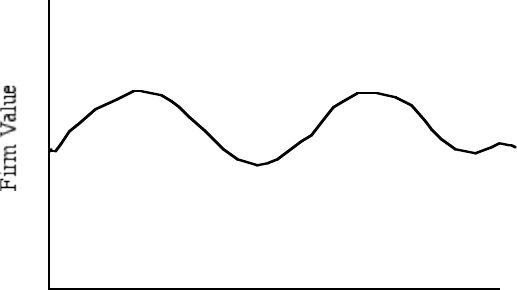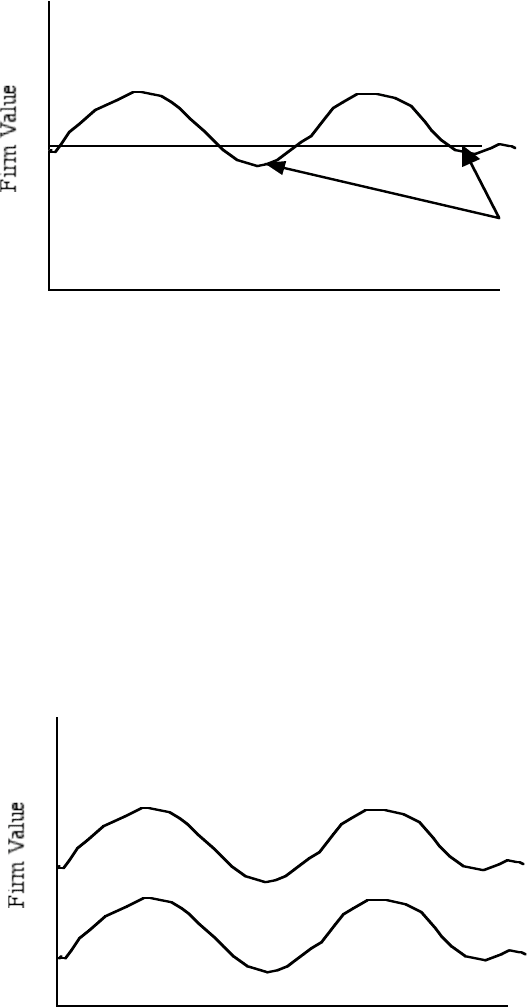Damodaran A. Applied corporate finance
Подождите немного. Документ загружается.


24
24
this operating income, is only 10%. Table 9.9 examines the effect on leverage of cutting
dividends to zero and using operating cash flows to take on projects and repay debt.
Table 9.9: Estimated Debt Ratios – Time Warner
Current Year
1
2
3
4
5
Equity
$16,689
$19,051
$21,694
$24,651
$27,960
$31,663
Debt
$9,934
$9,745
$9,527
$9,276
$8,988
$8,655
Debt/(Debt+Equity)
37.31%
33.84%
30.52%
27.34%
24.33%
21.47%
Capital
Expenditures
$300
$330
$363
$399
$439
$483
- Depreciation
$437
$481
$529
$582
$640
$704
- Net Income
$35
$39
$52
$68
$88
$112
- Dividends
$67
$0
$0
$0
$0
$0
= New Debt
($105)
($189)
($218)
($251)
($289)
($332)
Beta
1.30
1.25
1.21
1.17
1.14
1.11
Cost of Equity
14.15%
13.87%
13.63%
13.42%
13.24%
13.08%
Growth Rate
10.00%
10.00%
10.00%
10.00%
10.00%
Payout Ratio
11%
0%
0%
0%
0%
0%
Allowing for a growth rate of 10% in operating income, Time Warner repays $ 189
million of its outstanding debt in the first year. By the end of the fifth year, the growth in
equity and the reduction in debt combine to lower the debt ratio to 21.47%.
This spreadsheet allows you to estimate the effects of changing dividend policy or
capital expenditures on debt ratios over time.

25
25
9.6. ☞: Investing in Other Business Lines
In the analysis above, we have argued that firms should invest in projects as long
as the return on equity is greater than the cost of equity. Assume that a firm is considering
acquiring another firm with its debt capacity. In analyzing the return on equity the
acquiring firm can make on this investment, we should compare the return on equity to
a. the cost of equity of the acquiring firm
b. the cost of equity of the acquired firm
c. a blended cost of equity of the acquired and acquiring firm
d. none of the above
Explain.
In Practice: Security Innovation and Changing Capital Structure
While the changes in leverage discussed so far in this chapter have been
accomplished using traditional securities such as straight debt and equity, firms that have
specific objectives on leverage may find certain products that are designed to meet those
objectives. Consider a few examples:
• Hybrid securities such as convertible bonds are combinations of debt and equity
that change over time as the firm changes. To be more precise, if the firm
prospers and its equity value increases, the conversion option in the convertible
bond will become more valuable, thus increasing the equity component of the
convertible bond and decreasing the debt component (as a percent of the value of
the bond). If the firm does badly and its stock price slides, the conversion option
(and the equity component) will become less valuable and the debt ratio of the
firm will increase.
• An alternative available to a firm that wants to increase leverage over time is a
forward contract to buy a specified number of shares of equity in the future. These
contracts lock the firms into reducing their equity over time and may carry a more
positive signal to financial markets than would an announcement of plans to
repurchase stock, since firms are not obligated to carry through on these
announcements.

26
26
• A firm with high leverage, faced with a resistance from financial markets to
common stock issues, may consider more inventive ways of raising equity, such
as using warrants and contingent value rights. Warrants represent call options on
the firm’s equity whereas contingent value rights are put options on the firm’s
stock. The former have appeal to those who are optimistic about the future of the
company and the latter make sense for risk averse investors who are concerned
about the future.
Choosing the Right Financing Instruments
In Chapter 7, we presented a variety of ways in which firms can raise debt and
equity. Debt can be bank debt or corporate bonds, can vary in maturity from short to
long term, can have fixed or floating rates and can be in different currencies. In the case
of equity there are fewer choices, but firms can still raise equity from common stock,
warrants or contingent value rights. While we suggested broad guidelines that could be
used to determine when firms should consider each type of financing, we did not develop
a way in which a specific firm can pick the right kind of financing.
In this section, we lay out a sequence of steps by which a firm to choose the right
financing instruments. This analysis is useful not only in determining what kind of
securities should be issued to finance new investments, but also in highlighting
limitations in a firm’s existing financing choices. The first step in the analysis is an
examination of the cash flow characteristics of the assets or projects that will be financed;
the objective is to try to match the cash flows on the liability stream as closely as possible
to the cash flows on the asset stream. We then superimpose a series of considerations that
may lead the firm to deviate from or modify these financing choices.
First, we consider the tax savings that may accrue from using different financing
vehicles, and weigh the tax benefits against the costs of deviating from the optimal
choices. Next, we examine the influence that equity research analysts and ratings agency
views have on the choice of financing vehicles; instruments that are looked on favorably
by either or, better still, both groups will clearly be preferred to those that evoke strong
negative responses from one or both groups. We also factor in the difficulty that some
firms might have in conveying information to markets; in the presence of asymmetric

27
27
information, firms may have to make financing choices that do not reflect their asset mix.
Finally, we allow for the possibility that firms may want to structure their financing to
reduce agency conflicts between stockholders and bondholders.
I. Matching financing cash flows with asset cash flows
The first and most important characteristic a firm has to consider in choosing the
financing instrument it will use to raise funds is the cash flow patterns of the assets that
are to be financed with this instrument.
Why match Asset Cash Flows to Cash Flows on Liabilities
We will begin with the premise that the cash flows of a firm’s liability stream
should match the cash flows of the assets that they finance. Let us begin by defining firm
value as the present value of the cash flows generated by the assets owned by the firm.
This firm value will vary over time, not only as a function of firm-specific factors such as
project success, but also as a function of broader macro economic variables such as
interest rates, inflation rates, economic cycles and exchange rates. Figure 9.2 represents
the time series of firm value for a hypothetical firm, where all the changes in firm value
are assumed to result from changes in macro economic variables.
Figure 9.2: Firm Value over time with Short Term Debtt
Time (t)
Firm Value
Value of Equity
This firm can choose to finance these assets with any financing mix it wants. The value
of equity at any point in time is the difference between the value of the firm and the value
of outstanding debt. Assume, for instance, that the firm chooses to finance the assets
shown in Figure 20.2 using very short term debt, and that this debt is unaffected by

28
28
changes in macro economic variables. Figure 9.3 provides the firm value, debt value, and
equity value over time for the firm.
Figure 9.3: Firm Value over time with Long Term Debtt
Time (t)
Firm Value
Debt Value
Firm is bankrupt
Note that there are periods when the firm value drops below the debt value, which would
suggest that the firm is technically bankrupt in those periods. Firms that weigh this
possibility into their financing decision will therefore borrow less.
Now consider a firm which finances the assets described in Figure 9.2 with debt
that matches the assets exactly, in terms of cash flows, and also in terms of the sensitivity
of debt value to changes in macro economic variables. Figure 9.4 provides the firm value,
debt value and equity value for this firm.
Figure 9.4: Firm Value over time with Long Term Debtt
Time (t)
Firm Value
Debt Value
Value of Equity
Since debt value and firm value move together, the possibility of default is significantly
reduced. This, in turn, will allow the firm to carry much more debt, and the added debt

29
29
should provide tax benefits that make the firm more valuable. Thus, matching liability
cash flows to asset cash flows allows firms to have higher optimal debt ratios.
9.7. ☞: The Rationale for Asset and Liability Matching
In chapter 4, we argued that firms should focus on only market risk, since firm-
specific risk can be diversified away. By the same token, it should not matter if firms use
short term debt to finance long term assets, since investors in these firms can diversify
away this risk anyway.
a. True
b. False
Comment.
Matching Liabilities to Assets
The first step every firm should take towards making the right financing choices
is to understand how cash flows on its assets vary over time. In this section, we consider
five aspects of financing choices, and how they are guided by the nature of the cash flows
generated by assets. We begin by looking at the question of financing maturity, i.e, the
choice between long term, medium term and short term debt, and argue that this choice
will be determined by how long term asset cash flows are. Next, we examine the choice
between fixed and floating rate debt, and how this choice will be affected by the way
inflation affects the cash flows on the assets financed by the debt. Third, we look at the
currency of in which the debt is to be denominated and link it to the currency in which
asset cash flows are generated. Fourth, we evaluate when firms should use convertible
debt instead of straight rate debt, and how this determination should be linked to how
much growth there is in asset cash flows. Finally, we analyze other features that can be
attached to debt, and how these options can be used to insulate a firm against specific
factors that affect cash flows on assets, either positively or negatively.
A. Financing Maturity
Firms can issue debt of varying maturities, ranging from very short term to very
long term. In making this choice, they should first be guided by how long term the cash
flows on their assets are. For instance, firms should not finance assets that generate cash
flows over the short term (say 2 to 3 years) using 20-year debt. In this section, we begin

30
30
by examining how best to assess the life of assets and liabilities, and then we consider
alternative strategies to matching financing with asset cash flows.
Measuring the Cashflow Lives of Liabilities and Assets
When we talk about projects as having a 10-year life or a bond as having a 30-
year maturity, we are referring to the time when the project ends or the bond comes due.
The cash flows on the project, however, occur over the 10-year period, and there are
usually interest payments on the bond every six months until maturity. The duration of
an asset or liability is a weighted maturity of all the cash flows on that asset or liability,
where the weights are based upon both the timing and the magnitude of the cash flows. In
general, larger and earlier cash flows are weighted more than are smaller and later cash
flows. The duration of a 30-year bond, with coupons every six months, will be lower than
30 years, and the duration of a 10-year project, with cash flows each year, will generally
be lower than 10 years.
A simple measure
11
of duration for a bond, for instance, can be computed as
follows:
Duration of Bond =
dP/dr
(1 + r)
=
t *Coupon
t
(1 + r)
t
t =1
t =N
!
+
N * Face Value
(1 + r)
N
"
#
$
$
%
&
'
'
Coupon
t
(1 + r)
t
t =1
t = N
!
+
Face Value
(1 + r)
N
"
#
$
$
%
&
'
'
where N is the maturity of the bond, and t is when each coupon comes due. Holding other
factors constant, the duration of a bond will increase with the maturity of the bond and
decrease with the coupon rate on the bond. For example, the duration of a 7%, 30-year
coupon bond, when interest rates are 8% and coupons are paid each year, can be written
as follows:
Duration of 30 - year Bond =
dP/dr
(1 + r)
=
t * $ 70
(1.08)
t
t =1
t= 30
!
+
30* $1000
(1.08)
30
"
#
$
$
%
&
'
'
$ 70
(1.08)
t
t=1
t = 30
!
+
$1000
(1.08)
N
"
#
$
$
%
&
'
'
= 12.41
11
This measure of duration estimated above is called Macaulay duration, and it does make same strong
assumptions about the yield curve; specifically, the yield curve is assumed to be flat and move in parallel
shifts. Other duration measures change these assumptions. For purposes of our analysis, however, a rough
measure of duration will suffice.

31
31
What does the duration tell us? First, it provides a measure of when, on average,
the cash flows on this bond come due, factoring in both the magnitude of the cash flows
and the present value effects. This 30-year bond, for instance, has cash flows that come
due in about 12.41 years, after considering both the coupons and the face value. Second,
it is an approximate measure of how much the bond price will change for small changes
in interest rates. For instance, this 30-year bond will drop in value by approximately
12.41% for a 1% increase in interest rates. Note that the duration is lower than the
maturity. This will generally be true for coupon-bearing bonds, though special features in
the bond may sometimes increase duration.
12
For zero-coupon bonds, the duration is
equal to the maturity.
This measure of duration can be extended to any asset with expected cash flows.
Thus, the duration of a project or asset can be estimated in terms of its pre-debt operating
cash flows:
Duration of Project/Asset = dPV/dr =
t *CF
t
(1+ r)
t
t=1
t = N
!
+
N * Terminal Value
(1 + r)
N
"
#
$
%
&
'
CF
t
(1 + r)
t
t =1
t= N
!
+
Terminal Value
(1 + r)
N
"
#
$
%
&
'
where CF
t
is the after-tax cash flow on the project in year t, the terminal value is a
measure of how much the project is worth at the end of its lifetime of N years. The
duration of an asset measures both when, on average, the cash flows on that asset come
due, and how much the value of the asset changes for a 1% change in interest rates.
One limitation of this analysis of duration is that it keeps cash flows fixed, while
interest rates change. On real projects, however, the cash flows will be adversely affected
by the increases in interest rates, and the degree of the effect will vary from business to
business - more for cyclical firms (automobiles, housing) and less for non-cyclical firms
(food processing). Thus the actual duration of most projects will be higher than the
estimates obtained by keeping cash flows constant. One way of estimating duration
without depending upon the traditional bond duration measures is to use historical data. If
12
For instance, making the coupon rate floating, rather than fixed, will reduce the duration of a bond.
Similarly, adding a call feature to a bond will decrease duration, while making bonds extendible will
increase duration.

32
32
the duration is, in fact, a measure of how sensitive asset values are to interest rate
changes, and a time series of data of asset value and interest rate changes is available, a
regression of the former on the latter should yield a measure of duration:
Δ Asset Value
t
= a + b Δ Interest Rate
t
In this regression, the coefficient ‘b’ on interest rate changes should be a measure of the
duration of the assets. For firms with publicly traded stocks and bonds, the asset value is
the sum of the market values of the two. For a private company or for a public company
with a short history, the regression can be run, using changes in operating income as the
dependent variable –
Δ Operating Income
t
= a + b Δ Interest Rate
t
Here again, the coefficient “b” is a measure of the duration of the assets.
Illustration 9.5: Calculating Duration for Disney Theme Park
In this application, we will calculate duration using the traditional measures for
the Disney Bangkok Theme Park that we analyzed in chapter 5. The cash flows for the
project are summarized in Table 9.10, together with the present value estimates,
calculated using the cost of capital for this project of 10.66%.
Table 9.10: Calculating a Project’s Duration: Disney Theme Park
Year
Annual Cashflow
Terminal Value
Present Value
Present value *t
0
-$2,000
-$2,000
$0
1
-$1,000
-$904
-$904
2
-$833
-$680
-$1,361
3
-$224
-$165
-$496
4
$417
$278
$1,112
5
$559
$337
$1,684
6
$614
$334
$2,006
7
$658
$324
$2,265
8
$726
$323
$2,582
9
$802
$322
$2,899
10
$837
$9,857
$3,882
$38,821
$2,050
$48,609
Duration of the Project = 48,609/2,050 = 23.71 years

33
33
This would suggest that the cash flows on this project come due, on average, in 23.71
years. The duration is longer than the life of the project because the cash flows in the first
few years are negative.
9.8. ☞: Project Life and Duration
In investment analyses, analysts often cut off project lives at an arbitrary point
and estimate a salvage or a terminal value. If these cash flows are used to estimate project
duration, we will tend to
a. understate duration
b. overstate duration
c. not affect the duration estimate
Explain.
Duration Matching Strategies
In the last section, we considered ways of estimating the duration of assets and
liabilities. The basic idea is to match the duration of a firm’s assets to the duration of its
liabilities. This can be accomplished in two ways: by matching individual assets and
liabilities, or by matching the assets of the firm with its collective liabilities. In the first
approach, the Disney Theme Park project would be financed with bonds with duration of
approximately 24 years. While this approach provides a precise matching of each asset’s
characteristics to those of the financing used for it, it has several limitations. First, it is
expensive to arrange separate financing for each project, given the issuance costs
associated with raising funds. Second, this approach ignores interactions and correlations
between projects which might make project-specific financing sub-optimal for the firm.
Consequently, this approach works only for companies that have very large, independent
projects.
It is far more straightforward, and often cheaper, to match the duration of a firm’s
collective assets to the duration of its collective liabilities. If there is a significant
difference, the firm might have to consider changing the duration of its liabilities. For
instance, if Disney’s assets have a duration of 15 years, and its liabilities have a duration
of only 5 years, the firm should try to extend the duration of its liabilities. It can do so in
one of three ways. First, it can finance its new investments with debt of much longer
